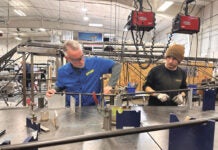 Terminology is important to many (myself usually included… but I can certainly slip up), so I present the following definition from an obscure A&P training document I had handy:
Terminology is important to many (myself usually included… but I can certainly slip up), so I present the following definition from an obscure A&P training document I had handy:
“A jig controls and guides the cutting tool to work at a predefined location on a workpiece. Fixtures are used to support and locate a workpiece. Fixtures do not guide the tool on a workpiece like a jig.”
By that definition, I finished building a fixture today – one that will be used to build the tail of the F1 Rocket project we have been working on since the beginning of the year. Normally, people start metal airplane projects (especially those that look like RV’s) by building the tail. But when we took delivery of the Quick Build Rocket kit from almost twenty years ago (but untouched), Vince Frazier of Team Rocket held back the tail skeleton components because he wanted us to have the latest, strongest tail. As original F1 Rocket impresario Mark Frederick put it “we don’t want your tail to fall off!” And I concurred.
So the parts for the tail showed up later on, but in plenty of time – I have been pretty busy with other things and travel since the parts showed up shortly after AirVenture – an today I took the first step in building a good old-fashioned tail kit; I built a fixture. Those of you who built RV-3’s, -4,s, or -6’s know about tail construction fixtures – they hold all the parts in alignment during construction because not all the holes are pre-drilled. When I built my RV-8 starting in late 2003, I didn’t need a fixture because the recent technology of matched-hole fabrication meant I could; build it flat on the workbench. But the Rocket is a little older, so I needed a fixture – and I decided that I’d just “Go Big” ad make it out of steel. This baby isn’t going anywhere!
You can build the fixture out of wood, bolted aluminum, or steel – and since I have recently been working on my welding skills, and I have a steel yard close by, I chose that route because shipping aluminum box pieces ten feet long comes with an eye-watering price these days. This is built of 2”x3” steel box sections with a 1/8” wall thickness. Kitplanes Home Shop Machinist Bob Hadley cut out the gussets on his CNC plasma table, and the rest I cut with a chop saw, then spent a nice afternoon burning metal with the TiG torch.
After about three months of fuselage wiring (something I love to do, but eventually you need a break from any task) I am once again pulling out the metal tools and getting down to a good old tail build – this should be fun!













